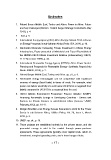Page 505 - 2016 - Vol. 40
P. 505
Endnotes
1. Roland Berger Middle East, Turkey and Africa: Power in Africa- Future
and Key Challenges (Munich: Roland Berger Strategy Consultants, May
2013), p. 4.
2. Ibid, p. 5.
3. International Energy Agency (IEA): Africa Energy Outlook 2014- A Focus
on Energy Prospects in sub-Saharan Africa (Paris: IEA, 2014), p. 48.
4. Dambudzo Muzenda: Increasing Private Investment in African Energy
Infrastructure, Paper presented at Ministerial and Expert Roundtable of
the NEPAD-OECD African Investment Initiative (Johannesburg: OECD,
11-12 November 2009), p. 44.
5. International Renewable Energy Agency (IRENA): Africa Power Sector:
Planning and Prospects for Renewable Energy- Synthesis Report (Abu
Dhabi: IRENA, 2015), p. 7.
6. Roland Berger Middle East, Turkey and Africa: op. cit., p. 9.
7. Renewable energy technologies can be competitive with traditional
sources of energy (fossil fuels) in terms of costs. For example, wind
power can deliver electricity at a cost below US $ 69 for a megawatt hour
(Mwh) compared to US $ 67 for a megawatt hour for coal.
8. United Nations Environment Programme Finance Initiative (UNEP):
Financing Renewable Energy in Developing Countries - Drivers and
Barriers for Private Finance in sub-Saharan Africa (Geneva: UNEP,
February 2012), pp. 10-11.
9. Morgan Brazilian et al: Energy Access Scenarios to 2030 for the Power
Sector in sub-Saharan Africa, Utilities Policy, Vol. 20, Issue 1, March
2012, p. 3.
10. UNEP: op. cit., p. 19.
11. These projects are established entirely by the private sector, and the
generated energy is sold to the market through power-purchase
agreements. These agreements typically cover capital costs, return on
investment, marginal operating costs, and a broad range of risks.
- 17 -

